
Kasanka National Park is a park located in the Chitambo District of Zambia’s Central Province. At roughly 390 km2 (150 sq mi), Kasanka is one of Zambia’s smallest national parks. Kasanka was the first of Zambia’s national parks to be managed by a private-public partnership. The privately funded Kasanka Trust Ltd has been in operation since 1986 and undertakes all management responsibilities, in partnership with the Department of National Parks and Wildlife. The park has an average elevation between 1,160 m (3,810 ft) and 1,290 m (4,230 ft) above mean sea level. It has a number permanent shallow lakes and water bodies with the largest being Wasa. There are five perennial rivers in the park, with the largest being the Luwombwa River. The Luwombwa is the only river that drains the NP, which flows out in the northwestern corner. It is a tributary of the Luapula, which further upstream also drains the Bangweulu Swamp and forms the main source of the Congo River. Although Kasanka NP is part of the Greater Bangweulu Ecosystem, there is no direct hydrological connection between the park and the Bangweulu Wetlands.

The Angolan genet or miombo genet is a genet species endemic to Southern Africa. It is considered common in this region and therefore listed as Least Concern in the IUCN Red List. Little is known about its ecology.
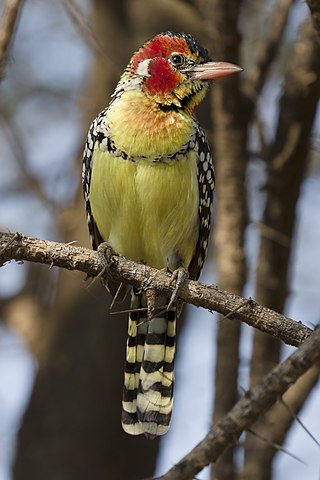
The red-and-yellow barbet is a species of African barbet found in eastern Africa. Males have distinctive black, red, and yellow plumage; females and juveniles are similar, but less brightly colored. The species lives in broken terrain and nests and roosts in burrows. Omnivorous, the species feeds on seeds, fruit, and invertebrates. Where not hunted, they are tame, but their feathers are used by certain tribes, such as the Maasai.
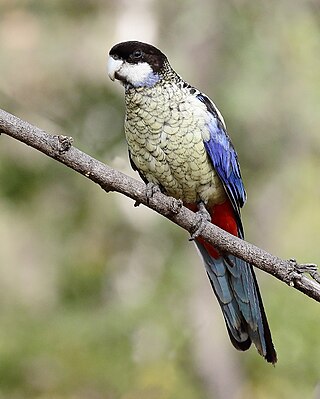
The northern rosella, formerly known as Brown's rosella or the smutty rosella, is a species of parrot native to northern Australia, ranging from the Gulf of Carpentaria and Arnhem Land to the Kimberley. It was described by Heinrich Kuhl in 1820, and two subspecies are recognised. The species is unusually coloured for a rosella, with a dark head and neck with pale cheeks—predominantly white in the subspecies from the Northern Territory and blue in the Western Australian subspecies hillii. The northern rosella's mantle and scapulars are black with fine yellow scallops, while its back, rump and underparts are pale yellow with fine black scallops. The long tail is blue-green, and the wings are black and blue-violet. The sexes have similar plumage, while females and younger birds are generally duller with occasional spots of red.

The grasshopper buzzard is a species of bird of prey in the family Accipitridae which is found in a narrow zone of sub-Saharan Africa north of the equator.

The bearded scrub robin, also known as the eastern bearded scrub robin, is a species of bird in the family Muscicapidae. It is found in eastern and southern Africa.
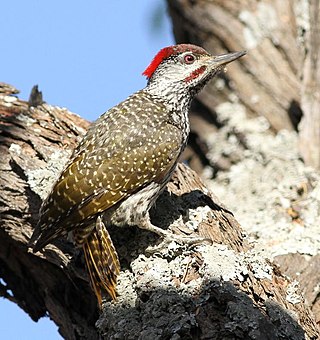
The golden-tailed woodpecker is a species of bird in the family Picidae. Its specific name commemorates the 5th Earl of Abingdon. It belongs to a species complex that includes the Knysna woodpecker to the south of its range, and the mostly allopatric Mombasa woodpecker to the northeast, with which it perhaps hybridizes.

Bennett's woodpecker is a species of bird in the family Picidae. It is found in woodlands and bushes in Africa. The International Union for Conservation of Nature (IUCN) has assessed it as a least-concern species.

The spot-crowned barbet is a species of bird in the family Capitonidae. It is found in Colombia and Panama.
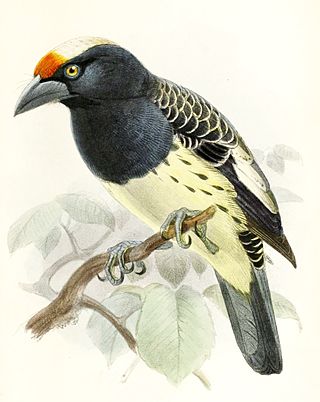
The orange-fronted barbet is a species of bird in the family Capitonidae. It is found Ecuador and Colombia.

The double-toothed barbet is a species of bird in the family Lybiidae. It is found in Angola, Benin, Burundi, Cameroon, Central African Republic, Republic of the Congo, Democratic Republic of the Congo, Ivory Coast, Equatorial Guinea, Ethiopia, Gabon, Ghana, Guinea, Guinea-Bissau, Kenya, Liberia, Mali, Nigeria, Rwanda, Sierra Leone, South Sudan, Tanzania, Togo, and Uganda. Within Lybius bidentatus, there are two subspecies: Lybius bidentatus bidentatus and Lybius bidentatus aequatorialis.

The black-billed barbet is a species of bird in the Lybiidae family.
The yellow-footed honeyguide is a species of bird in the family Indicatoridae. It is found in Cameroon, Guinea, Liberia, Sierra Leone, Ivory Coast, Ghana and Nigeria. Its natural habitat is subtropical or tropical moist lowland forests. It is threatened by loss of its forest habitat.
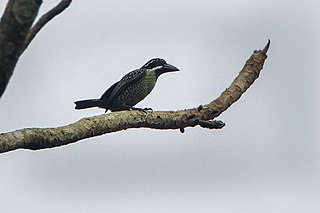
The hairy-breasted barbet is a species of bird in the family Lybiidae. It is found throughout the Africa tropical rainforest.
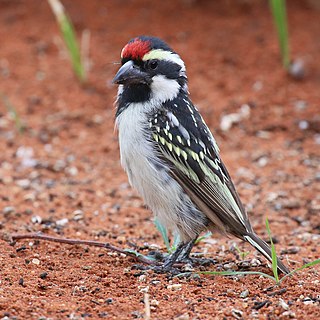
The acacia pied barbet or pied barbet is a species of bird in the family Lybiidae which is native to southern Africa.

The bar-tailed trogon is a species of bird in the family Trogonidae. It is a resident bird to central Africa that eats primarily insects and fruit.

















